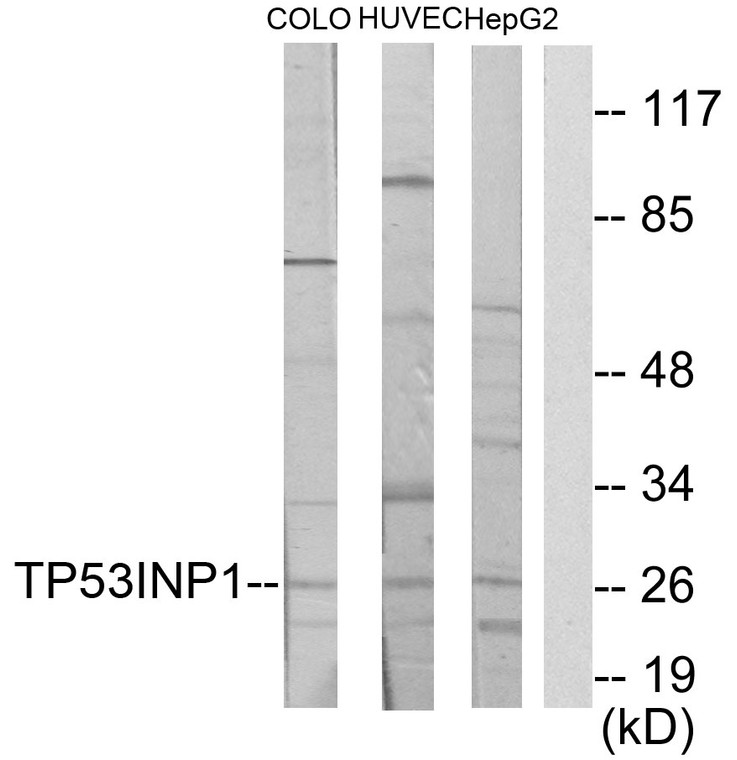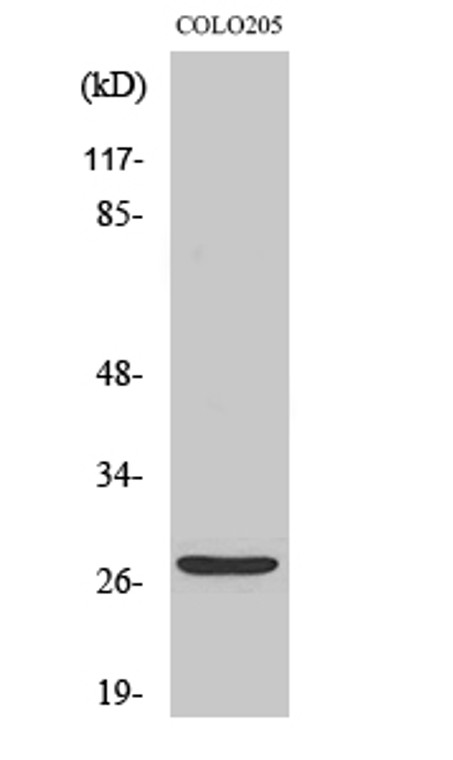| Host: |
Rabbit |
| Applications: |
WB/IHC/IF/ELISA |
| Reactivity: |
Human/Rat/Mouse |
| Note: |
STRICTLY FOR FURTHER SCIENTIFIC RESEARCH USE ONLY (RUO). MUST NOT TO BE USED IN DIAGNOSTIC OR THERAPEUTIC APPLICATIONS. |
| Short Description: |
Rabbit polyclonal antibody anti-Tumor protein p53-inducible nuclear protein 1 (171-220 aa) is suitable for use in Western Blot, Immunohistochemistry, Immunofluorescence and ELISA research applications. |
| Clonality: |
Polyclonal |
| Conjugation: |
Unconjugated |
| Isotype: |
IgG |
| Formulation: |
Liquid in PBS containing 50% Glycerol, 0.5% BSA and 0.02% Sodium Azide. |
| Purification: |
The antibody was affinity-purified from rabbit antiserum by affinity-chromatography using epitope-specific immunogen. |
| Concentration: |
1 mg/mL |
| Dilution Range: |
WB 1:500-1:2000IHC 1:100-1:300ELISA 1:40000IF 1:50-200 |
| Storage Instruction: |
Store at-20°C for up to 1 year from the date of receipt, and avoid repeat freeze-thaw cycles. |
| Gene Symbol: |
TP53INP1 |
| Gene ID: |
94241 |
| Uniprot ID: |
T53I1_HUMAN |
| Immunogen Region: |
171-220 aa |
| Specificity: |
TP53INP1 Polyclonal Antibody detects endogenous levels of TP53INP1 protein. |
| Immunogen: |
The antiserum was produced against synthesized peptide derived from the human TP53INP1 at the amino acid range 171-220 |
| Function | Antiproliferative and proapoptotic protein involved in cell stress response which acts as a dual regulator of transcription and autophagy. Acts as a positive regulator of autophagy. In response to cellular stress or activation of autophagy, relocates to autophagosomes where it interacts with autophagosome-associated proteins GABARAP, GABARAPL1/L2, MAP1LC3A/B/C and regulates autophagy. Acts as an antioxidant and plays a major role in p53/TP53-driven oxidative stress response. Possesses both a p53/TP53-independent intracellular reactive oxygen species (ROS) regulatory function and a p53/TP53-dependent transcription regulatory function. Positively regulates p53/TP53 and p73/TP73 and stimulates their capacity to induce apoptosis and regulate cell cycle. In response to double-strand DNA breaks, promotes p53/TP53 phosphorylation on 'Ser-46' and subsequent apoptosis. Acts as a tumor suppressor by inducing cell death by an autophagy and caspase-dependent mechanism. Can reduce cell migration by regulating the expression of SPARC. |
| Protein Name | Tumor Protein P53-Inducible Nuclear Protein 1Stress-Induced ProteinP53-Dependent Damage-Inducible Nuclear Protein 1P53dinp1 |
| Database Links | Reactome: R-HSA-6803204Reactome: R-HSA-6804756 |
| Cellular Localisation | CytoplasmCytosolNucleusPml BodyCytoplasmic VesicleAutophagosomeShuttles Between The Nucleus And The CytoplasmDepending On Cellular Stress ConditionsAnd Re-Localizes To Autophagosomes On Autophagy Activation |
| Alternative Antibody Names | Anti-Tumor Protein P53-Inducible Nuclear Protein 1 antibodyAnti-Stress-Induced Protein antibodyAnti-P53-Dependent Damage-Inducible Nuclear Protein 1 antibodyAnti-P53dinp1 antibodyAnti-TP53INP1 antibodyAnti-P53DINP1 antibodyAnti-SIP antibody |
Information sourced from Uniprot.org
12 months for antibodies. 6 months for ELISA Kits. Please see website T&Cs for further guidance









